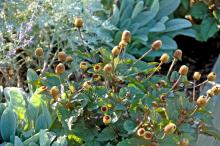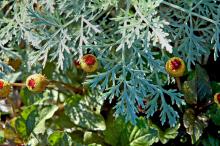Information Possibly Outdated
The information presented on this page was originally released on October 18, 2007. It may not be outdated, but please search our site for more current information. If you plan to quote or reference this information in a publication, please check with the Extension specialist or author before proceeding.
Peek-a-Boo plants look back at you
By Norman Winter
MSU Horticulturist
Central Mississippi Research & Extension Center
Spilanthes caused quite a stir this year at Mississippi State University's Fall Flower and Garden Fest held at the Truck Crops Experiment Station in Crystal Springs.
I say its botanical name first because the marketing and common names are really just a hoot. If you are looking for a plant to get a child interested in gardening, this one will do the trick.
One coworker thought this plant in a photo resembled some flowerbed alien looking up at the camera. The variety in the marketplace is called Peek-A-Boo. Some people think this is a plant that looks back at you while you are gazing at the bed. One of the common names is eyeball plant.
The flower has no petals. It is a golden, olive-sized ball with a round “eye” in the center. It looks like those funny glasses with eyeballs popping out and wiggling about. The round blossoms are borne on 4-inch stems. After examining the flowers, you will probably have a hard time believing this plant is in the Aster family.
The edible foliage is dark green with a hint of bronze. It has a peppery taste and is used in salads. Another common name is the “toothache plant” because the leaves have a numbing effect when chewed.
But beware: chewing the flowers will cause quite a commotion in your mouth, from a warm sensation to intense bitterness to salivating to a loss of all oral sensation for a few minutes. My guess is that you'll just want it for spot plantings in the garden or mixed containers and will enjoy the unique, colorful flowers without turning the plant into a munchy.
Everyone in the trade calls it Spilanthes, but this is one of those plants that has a new name, Acmella oleracea. It is from South America and is perennial in warmer zones 10-11. The rest of us will enjoy it as an annual like we do the petunia. I find it incredibly strange that none of my herb books mention it. Do a web search and you will see every herbalist in the country is touting it. You will also find it being used for much more than what I have described.
It can be grown in full sun to filtered light. It will bloom all summer and reach 12 to 18 inches tall, spreading outward more than a foot. This is a plant that appreciates fertile, well-drained soil with a layer of mulch. Frequent light applications of fertilizer are also recommended.
In the MSU garden at Crystal Springs, we partnered it with Powis Castle Artemisia, Lamb's Ear and Russian Sage, another gray-leafed plant. The blue flowers of the Russian Sage also made the combination quite interesting.
I have seen Spilanthes used as a simple gift plant placed in a decorative container with a ribbon. It is also attractive as a potted mum and, of course, can be planted in the ground if desired.
Look for it next spring. And for the 6,500 visitors who came to the Fall Flower and Garden Fest: we enjoyed having you!









